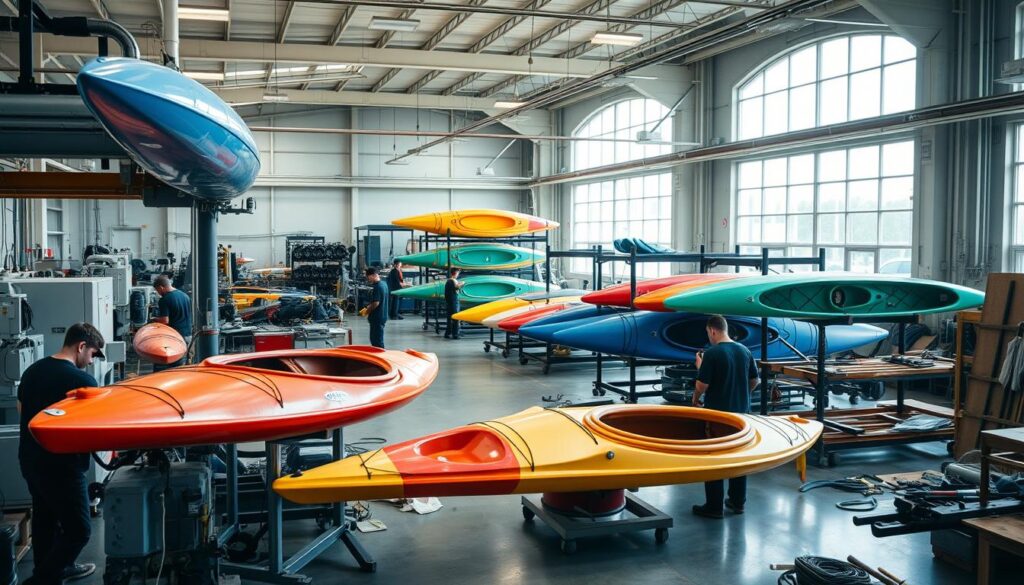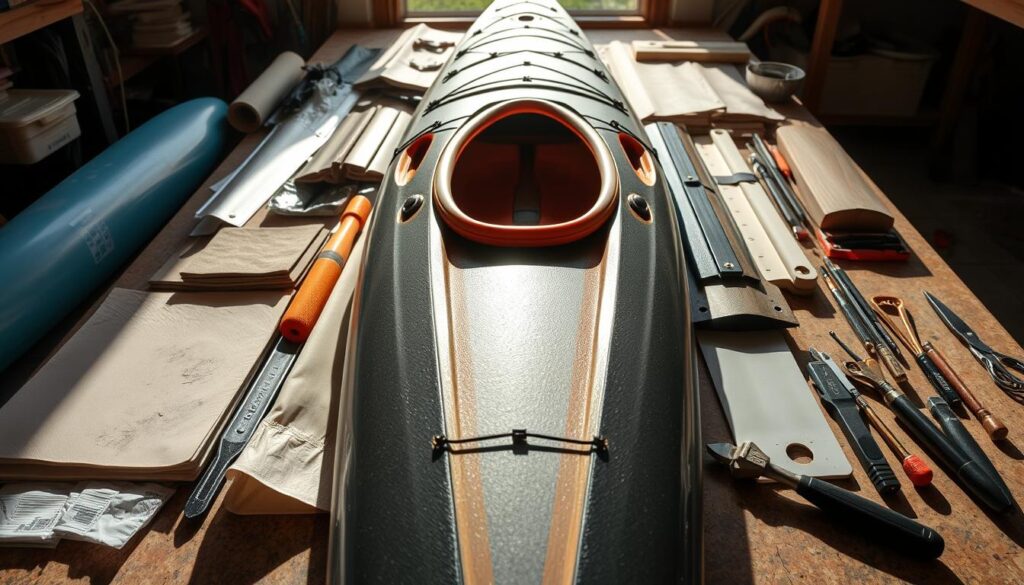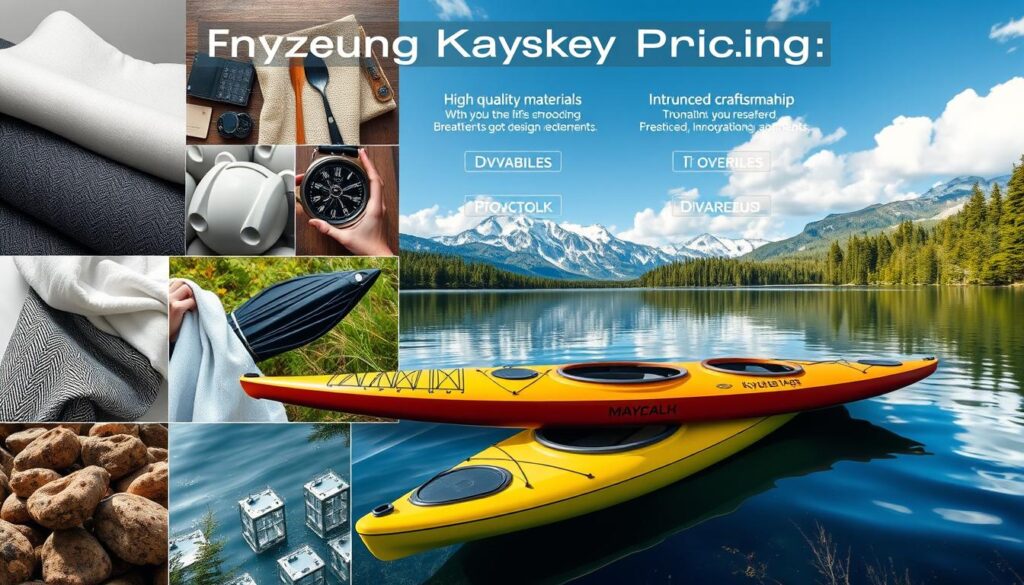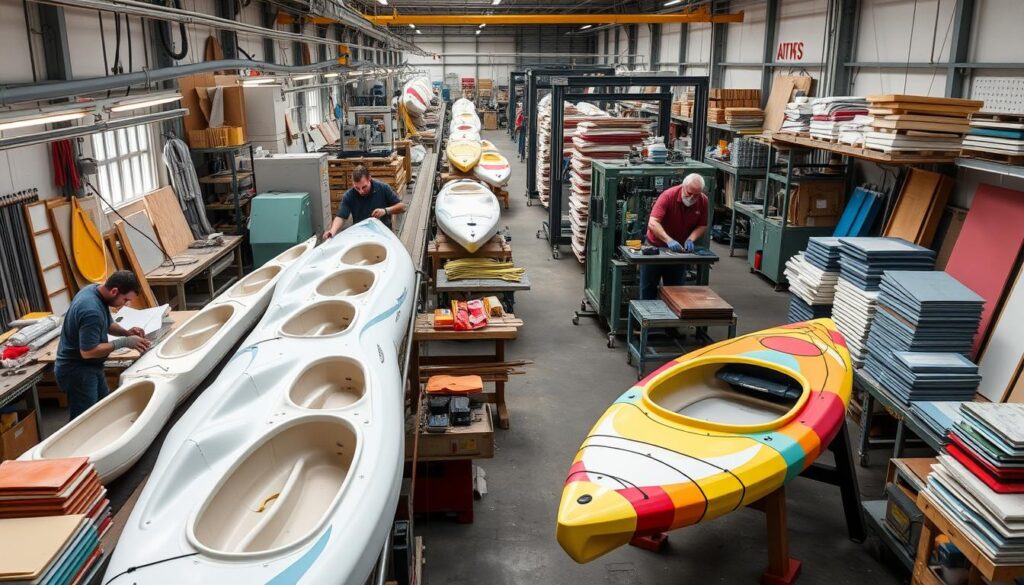
When you start exploring kayaking, you might find yourself asking, why are kayaks so expensive? It’s a common question, especially when high-end kayaks can cost thousands of dollars. The price of a quality kayak goes far beyond just the materials used to make it.
So, why are kayaks so expensive? There are many factors at play, including advanced technology, precise engineering, and specialized design. Every element, from the high-grade materials to the intricate manufacturing processes, contributes to the overall cost.
Manufacturers invest heavily in creating kayaks that excel in performance, durability, and safety. These kayaks are designed to meet the needs of professional kayakers as well as outdoor enthusiasts. They must endure rough waters, provide easy maneuverability, and ensure maximum comfort. All of this explains why are kayaks so expensive and why investing in a good one is often worth the cost.
Key Takeaways
- Advanced materials significantly impact kayak pricing
- Precision manufacturing drives up production costs
- Research and development require substantial investment
- Performance features contribute to higher prices
- Brand reputation affects overall kayak cost
Understanding the High Cost of Quality Kayak Materials
Exploring expensive kayak materials shows that making them is costly. The materials used are more complex than you might think.

The cost of kayaks comes from the materials and how they’re made. Companies spend a lot on materials that are durable, light, and withstand water and weather.
Premium Polymer and Composite Construction
Kayak materials vary from simple plastics to advanced composites. Each type has its own benefits:
- Polyethylene: Affordable but heavier
- Fiberglass: Lightweight and responsive
- Carbon fiber: Ultra-lightweight and high-performance
- Kevlar: Extremely durable and impact-resistant
Impact of Material Durability on Price
Durability affects kayak prices. Better materials last longer and perform better, which means they cost more.
| Material | Average Lifespan | Price Range |
|---|---|---|
| Polyethylene | 5-7 years | $300-$800 |
| Fiberglass | 8-12 years | $800-$1,500 |
| Carbon Fiber | 10-15 years | $1,500-$3,000 |
Advanced Material Technology Costs
New material technologies make kayaks more expensive. Research and development investments in stronger, lighter, and more responsive materials cost a lot.
“Innovation in kayak materials is not just about performance, but about pushing the boundaries of what’s possible in watercraft design.” – Kayak Engineering Expert
Knowing about these materials helps explain why some kayaks are pricier. The right material can greatly improve your paddling experience, making the cost worth it for serious enthusiasts.
Why Are Kayaks So Expensive: A Detailed Breakdown

To understand why kayaks cost a lot, we need to look at several factors. Kayak prices aren’t just about the boat. They involve design, materials, making, and market trends.
Here are the main things that make kayaks pricey:
- Research and development investments
- High-quality material selection
- Specialized manufacturing processes
- Brand reputation and performance features
“A kayak is more than just a watercraft—it’s a precision-engineered piece of equipment designed for performance and durability.” – Professional Kayaking Magazine
The price of your kayak shows the hard work behind it. Makers spend a lot on creating new designs. These designs make paddling better, more stable, and enjoyable.
| Cost Component | Percentage of Total Price |
|---|---|
| Materials | 35% |
| Manufacturing | 25% |
| R&D | 20% |
| Marketing | 10% |
| Profit Margin | 10% |
Kayak prices are not random. They are carefully thought out. They balance performance, quality, and what the market wants. Every dollar is an investment in better water travel.
The Complex Manufacturing Process Behind Modern Kayaks
Making a top-notch kayak is a detailed process that affects its cost and how well it performs. This process shows why kayaks can be pricey.

The journey from raw materials to a finished kayak is complex. It needs precision, skill, and new techniques. The way a kayak is made greatly influences its price and quality.
Rotomolding vs Hand-Layup Methods
There are two main ways to make kayaks:
- Rotomolding: A cost-effective method for making plastic kayaks
- Hand-Layup: A more labor-intensive process for creating high-end composite kayaks
Rotomolding heats and rotates a mold to make a plastic shell. This method is cheaper but might affect some performance.
Quality Control and Testing Procedures
| Quality Control Stage | Purpose | Impact on Cost |
|---|---|---|
| Material Inspection | Verify raw material integrity | Increases initial production costs |
| Structural Testing | Ensure kayak durability and performance | Adds significant testing expenses |
| Water Performance Evaluation | Validate kayak handling and stability | Requires specialized testing equipment |
Skilled Labor Requirements
More than just materials and tools affect kayak cost. Skilled workers turn raw materials into top-notch kayaks. Their expertise ensures each kayak meets high standards.
Precision in kayak manufacturing is not an expense, but an investment in your water adventure.
The complexity of making kayaks explains their high prices. From choosing materials to the final quality checks, each step is crucial. It all leads to a reliable and top-performing watercraft.
Brand Reputation and Premium Pricing Strategies
When looking at kayak prices, the brand’s reputation is key. Top kayak makers use their good names to charge more than just the cost of making them.
Big kayak brands spend a lot on building trust and value. This effort shows in their prices, which reflect their place in the market.
- Reputation drives consumer perception of quality
- Brand heritage influences purchasing decisions
- Marketing investments impact product pricing
“A strong brand can command 20-30% higher prices compared to lesser-known competitors” – Kayak Industry Insights Report
Buying a kayak is shaped by the brand’s reputation. Companies like Wilderness Systems, Ocean Kayak, and Hobie are known for top quality. This lets them keep their prices higher.
| Brand | Reputation Score | Average Price Range |
|---|---|---|
| Wilderness Systems | 9.2/10 | $800-$1,500 |
| Ocean Kayak | 8.7/10 | $600-$1,200 |
| Hobie | 9.5/10 | $1,000-$2,500 |
Knowing about kayak brands helps you choose wisely. Brands that always offer great performance and new ideas can charge more. They do this because they have a history of quality and happy customers.
Research and Development Investments in Kayak Design
Kayak makers spend a lot on new designs and tech. This effort leads to top-notch kayak features. It also explains why modern kayaks cost more.
Creating new kayak tech is a big deal. It takes a lot of money and brainpower. Designers and engineers work hard to make kayaks better for paddling and fun.
Innovation Costs in Hull Design
Hull design is key in kayak making. Companies spend a lot on:
- Shapes that cut through water better
- Stability that keeps you steady
- Easy-to-turn designs
Performance Enhancement Features
Top kayak features come from lots of research and testing. These include:
- Systems to track your path
- Seats that are comfy
- Ways to make kayaks lighter
| Research Area | Investment Focus | Expected Outcome |
|---|---|---|
| Hull Geometry | Computational Fluid Dynamics | Improved Speed and Efficiency |
| Material Science | Lightweight Composite Development | Enhanced Durability |
| Ergonomics | User Comfort Studies | Better Paddling Experience |
Safety Technology Integration
Today’s kayak designs focus on safety. They use tech to keep paddlers safe and make kayaking better.
“Innovation is not just about creating something new, but about solving real-world challenges for kayakers.” – Professional Kayak Design Engineer
These investments mean better kayaks. They offer better performance, safety, and fun for users.
Transportation and Storage Impact on Retail Prices
The journey of a kayak from the factory to your hands is complex. It involves transportation and storage challenges that affect its price. Kayak transportation costs are more than just shipping. Several factors increase the overall cost.
Shipping large, bulky watercraft is a big challenge. Kayak makers have to manage many things that affect the price:
- Dimensional shipping rates for oversized items
- Specialized packaging requirements
- Fragile handling considerations
- Warehouse storage expenses
Retailers have big costs when storing kayaks. Things that affect kayak cost include:
- Dedicated warehouse space
- Climate-controlled storage conditions
- Inventory management systems
- Insurance for high-value watercraft
“Every inch of storage and every mile of transportation adds to the final price consumers pay for their kayak.” – Outdoor Gear Industry Expert
Modern kayak retailers need to invest in advanced inventory tracking and storage solutions. These investments protect the product’s integrity but also raise the price for buyers.
Knowing about these costs helps kayak buyers understand the journey from factory to their own watercraft collection.
Market Demand and Supply Chain Factors
The kayak market has complex dynamics that affect prices and availability. Knowing these factors helps you shop better.
Kayak demand changes throughout the year, leading to price shifts. Manufacturers and sellers adjust their plans for several reasons:
- Seasonal recreational patterns
- Tourism trends
- Outdoor adventure preferences
Seasonal Pricing Dynamics
Kayak prices change a lot with the seasons. Summer is the busiest time, making prices go up. Companies make more money when people are on vacation or going on adventures.
“Price is what you pay. Value is what you get.” – Warren Buffett
Global Supply Chain Challenges
Recently, kayak production has faced big problems. Shortages of raw materials, shipping delays, and limited factory space make prices hard to predict.
- Raw material cost fluctuations
- International shipping delays
- Manufacturing capacity constraints
Smart shoppers can save by knowing when to buy. They understand the demand and supply chain issues.
Performance Features That Drive Up Kayak Costs
Buying a high-end kayak is more than just getting a boat. It’s about getting a top-notch piece of engineering. These kayaks come with premium features that make your paddling better. The cost goes up because of the expensive materials and advanced designs.
For professional kayakers, the right features make every trip special. These include:
- Hydrodynamic hull shapes for better speed and control
- Adjustable seats for comfort in any position
- Waterproof storage to keep gear dry
- Technologies for better tracking and stability
These features need a lot of research and special materials. For example, using lightweight carbon fiber can add hundreds to the price. But it makes the kayak perform better.
“Performance comes at a price, and in kayaking, that price is often reflected in the sophisticated engineering behind each vessel.” – Professional Kayaking Magazine
The most expensive materials in kayaks are not just durable. They’re about giving you a better paddling experience. Features like computer-designed hulls and precise deck layouts make every stroke count.
When looking at high-performance kayaks, remember the cost is for quality and comfort. It’s an investment in enjoying your time on the water.
Conclusion
Kayaks are pricey because of their design, materials, and new ideas. The cost of a kayak goes beyond just making it. It’s about the advanced tech, careful engineering, and top-notch materials that make them more than just boats.
Quality kayaks need a lot of research and development. Brands like Wilderness Systems and Hobie work hard to make them light, strong, and ready for tough waters. The detailed designs, special making methods, and high-quality materials all add to the price.
Looking into why kayaks cost so much, we see many factors at play. From new polymer composites to strict quality checks, each kayak shows off top engineering. Things like market trends, demand, and global supply chains also affect prices. This ensures you get a kayak that’s well-made and ready for many adventures.
In the end, the price of a kayak is about the amazing experiences it offers. Even though it might seem expensive, you’re really buying into durability, innovation, and the chance for many exciting water trips.
FAQ
Why are kayaks so expensive?
Kayaks cost a lot because of many factors. These include top-notch materials, complex making processes, and lots of research. Also, the brand’s reputation and special design features play a big role. The price reflects the advanced engineering and durability of modern kayaks.
What materials make kayaks costly?
Premium kayaks use materials like carbon fiber and fiberglass. These materials are strong, light, and last long. They are much pricier than common materials, making the kayak more expensive.
How does manufacturing impact kayak pricing?
The making of kayaks uses advanced techniques like rotomolding. This process needs special skills and equipment. Each kayak is tested and crafted carefully, adding to the cost.
Do brand reputation and research affect kayak prices?
Yes, they do. Brands like Wilderness Systems invest a lot in research and new designs. Their reputation and innovation justify the higher prices of their kayaks.
Are seasonal and market factors important in kayak pricing?
Yes, kayak prices change with the seasons and market. Prices go up during peak seasons. Global supply chain issues can also affect costs.
What performance features drive up kayak costs?
High-end kayaks have features like adjustable seats and advanced designs. They also have storage systems and special tracking mechanisms. These features improve the paddling experience but increase costs.
How do transportation and storage affect kayak prices?
Kayaks are big and need special care during transport and storage. Shipping and storage costs add to the price for both manufacturers and retailers.
Are expensive kayaks worth the investment?
For serious kayakers, a high-quality kayak is worth it. They offer better performance, durability, and safety. Although they cost more upfront, they last longer and provide a better experience.
Can I find affordable kayaks with good quality?
Yes, there are affordable kayaks from reputable brands. Entry-level kayaks use cost-effective materials but still offer good quality. Looking around and comparing models can help find a balance between price and quality.
How often do kayak technologies and prices change?
Kayak technologies change fast, with new materials and designs coming out often. Prices can change yearly due to new tech, demand, and manufacturing improvements. It’s important to keep up with the latest trends.

